| Franz Xavier Bergmann | |
|---|---|
 Foundry seal. "B" in an urn-shaped cartouche Foundry seal. "B" in an urn-shaped cartouche | |
| Born | (1861-07-27)July 27, 1861 Vienna, Austrian Empire |
| Died | January 1, 1936(1936-01-01) (aged 74) Vienna, Austria |
| Nationality | Austrian |
| Occupation | Factory owner |
Franz Xavier Bergman(n) (July 27, 1861 – January 1, 1936) was the owner of a Viennese foundry who produced numerous patinated and cold-painted bronzes, Oriental, erotic, and animal figures, the latter often humanized or whimsical, humorous objets d'art.
Early life and career

Bergmann was noted for his detailed and colorful work. He signed with either a letter 'B' in an urn-shaped cartouche or 'Nam Greb' – 'Bergman' in reverse. These marks were used to disguise his identity on erotic works.
His father, Franz Bergmann (September 26, 1838 – 1894), was a professional chaser from Gablonz who came to Vienna and founded a small bronze factory in 1860. Franz Xavier Bergmann inherited the company and opened a new foundry in 1900. Many of the bronzes from the 1900s were still based on designs from his father's workshop.
Bergmann is often incorrectly described as a sculptor, but he was not; he was a foundry owner. His workshops employed, on a temporary basis, many anonymous sculptors. Bruno Zach employed Bergmann to edit and cast some of his works, with some of the more erotic ones being signed as "Prof. Tuch", a pseudonym used by Zach. At the turn of the 19th century there were about fifty workshops producing Vienna bronzes.
'Cold-painted bronze' refers to pieces cast in Vienna and then decorated in several layers with so-called dust paint; the know-how for the mix of this kind of paint has been lost. The color was not fired, hence 'cold painted'. The painting was carried out mainly by women working at home, a typical cottage industry.
Sensuous poses of young women in the Art Nouveau style were disguised by a covering that revealed all when a button was pushed or a lever moved. Often carefully sculpted animals, such as bears, could be opened to reveal an erotic figure inside.
Foundry closure
The Bergmann foundry was closed in 1930 due to the Great Depression. It was reopened some years later by Robert Bergmann, son of Franz Xavier, and operated until his death in 1954, when the remaining stock and molds were sold to Karl Fuhrmann & Co.
Trivia
The playwright Henrik Ibsen had a small group of such characters which he referred to as his "devil orchestra"; a black boy climbing up a ladder on an elephant (NF.1914-0491), a cat chewing another with rice twigs (NF.0490A), singing after sheet music (NF.0490B), writing (NF.0490C), directing (NF.0490D), devils pulling each other in wheelbarrows (NF.0492) or carrying inkwells between them (NF.0488) and a frog sitting on an ashtray playing the banjo (NF.0489). Ibsen used these as inspiration: "There should be Troll in what I write," he said. Some of the characters were reported missing from the exhibitions on October 6, 1980, and were never returned. The rest of them are safely preserved at the playwright's desk in Ibsenmuseet in Oslo.
-
 Two small devils carrying inkwells between them. Norsk Folkemuseum, Ibsenmuseet (NF.1914-0488).
Two small devils carrying inkwells between them. Norsk Folkemuseum, Ibsenmuseet (NF.1914-0488).
-
 A frog sitting on an ashtray playing the banjo. Norsk Folkemuseum, Ibsenmuseet (NF.1914-0489).
A frog sitting on an ashtray playing the banjo. Norsk Folkemuseum, Ibsenmuseet (NF.1914-0489).
-
 A cat chewing another with rice twigs. Norsk Folkemuseum, Ibsenmuseet (NF.2019-0541), identical to the lost figurine (NF.1914-0490A).
A cat chewing another with rice twigs. Norsk Folkemuseum, Ibsenmuseet (NF.2019-0541), identical to the lost figurine (NF.1914-0490A).
-
 A black boy climbing up an elephant with a ladder. This one is identical to the lost figurine (NF.1914-0491).
A black boy climbing up an elephant with a ladder. This one is identical to the lost figurine (NF.1914-0491).
References
- ^ Berman, Harold (1974). Bronzes: Sculptors and Founders, 1800-1930, Vol. 1 (1st ed.). Atglen, Pennsylvania: Schiffer Publishing, Ltd. p. 761. ISBN 0-88740-700-5. Retrieved June 27, 2015.
- "Bruno Zach". designtoscano.com. Retrieved June 27, 2015.
- Erik Henning Edvardsen: Ibsen-museet. The Ibsen Museum. Oslo 1998, p. 22.